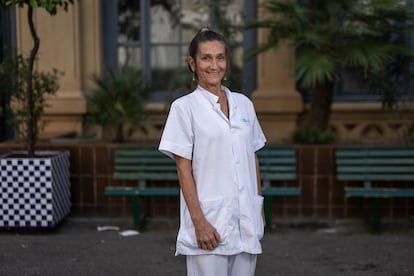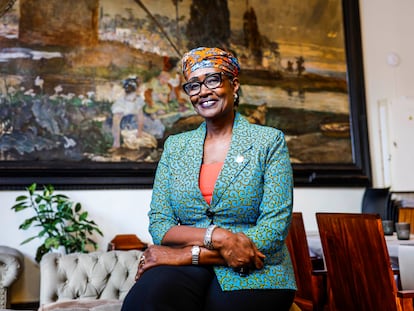Doctor Blanca Coll-Vinent: ‘Women’s symptoms have been poorly studied, and since we don’t recognize them, we ignore them’
The specialist from Hospital Clínic Barcelona oversaw the creation of ‘Ets una exagerada’, a collaborative book that unravels the biases caused in the health field by androcentric approaches to medicine


If a woman experiences cardiac arrest in the street, she has a lower chance of being resuscitated than a man. The reasons for this, says Doctor Blanca Coll-Vinent, are varied: “For fear of causing her harm, because they didn’t think that women could really be experiencing something so serious, or out of fear that they will be accused of sexual abuse because they have to touch her chest.” These are the arguments cited in a survey published by the scientific journal Circulation and highlighted in the book Ets una exagerada. Biaix de géner i sexe en salut (in English, You’re being dramatic. Gender and sex bias in health), which details gender and sex bias in medicine.
Coll-Vinent, who is the coordinator of the Clinical Commission on Sex and Gender in Health at Barcelona’s Hospital Clínic, oversaw, along with journalist Isabel Montané, the creation of the collaborative book, which describes a lack of gender-based perspective in approaches to a diverse array of illnesses. Through stories from doctors specializing in an array of fields and patients who have firsthand experience with androcentric medicine, Ets una exagerada tells of 13 medical conditions that are diagnosed and treated “based on the model of the universal man,” which assumes that sex and gender make no difference. In reality, they change everything.
Question. You say in the book that medicine has always had an androcentric gaze. Is that still the case?
Answer. It’s changed, but we have a long way to go. It continues to be a gaze that is fundamentally androcentric and, above all, unique. That is to say, it is a single model that is normally masculine and does not distinguish, does not separate, does not keep in mind the differences of each person and, especially, those pertaining to sex and gender, which are two extremely important characteristics.
Q. What implications does that have in clinical practice?
A. There can be differences in the way that the diseases’ symptoms manifest. The best-known example is that of the coronary ischemia, associated with heart attacks, which may show up in women not as an oppressive chest pain that extends to the neck, but rather, as fatigue, choking, discomfort … Women do not identify it as a heart attack, and may come in later. We, the health personnel, may not identify it from the outset, which can delay diagnosis.
Q. In the book, you say that “these sex and gender biases lead to discrimination, inequality and negative consequences.” What is the most flagrant example of this?
A. The example that is most unsettling to me is medicine dosage. They adjust for age, weight, if a person has kidney damage or not, but they’re not adjusting for sex and much less gender. We know that women respond differently because our bodies eliminate pharmaceuticals much more slowly. There are many factors that lead to us accumulating more pharmaceuticals in our bodies and getting rid of less, which means we need lower doses because if not, there’s a risk of poisoning. It’s also important to know that some pharmaceuticals are effective when used by men and less so by women, and vice versa.
The pain experienced by men is considered typical and all others are atypical, even when women make up 50% of the population. That terminology alone should be eradicated
Q. What is it about women that has not been well examined?
A. We do what the protocols tell us we have to do. But as it hasn’t been studied, I cannot tell you what we do not do or what needs to be studied in the future. We have to study much more to see what has to be done to women that is not done to men or the other way around. It is very important to listen and ask what the needs are of the people we have in front of us, because maybe, the needs and health concerns of women are not the same as those of men.
Q. In doctors’ offices, are women listened to less? Are their words taken less seriously?
A. There’s a problem of time and resources: a consultation with a family doctor lasts eight, six or 15 minutes and there’s no time to listen to many things. I think that women are poorly listened to in general. And women are the most vulnerable group because they have poorly studied symptoms and since we don’t recognize them, we initially ignore them, attribute them to anxiety or classify them erroneously. But I think, in general, that lack of time and resources puts everything at risk. I insist: the primary problem is the fact that everyone is treated the same way.
Q. When it comes to coronary diseases, the book identifies a 20-minute diagnosis lag for women as compared to men. They take longer to come in, but once they are at the hospital, why is there a lag?
A. Once we do see them, if they don’t describe symptoms that we have classified as associated with coronary ischemia, we can miss it. And sometimes, they do come in for pain, but that pain doesn’t have the same characteristics as the pain that men usually experience, because it may not be an oppressive pain that extends to the neck. Sometimes it can be a discomfort, or it appears in the back, or increases with breathing. It can be different from what the books say is typical and, in addition, many times it is accompanied by other symptoms, and those may blur the diagnosis.
Q. For example?
A. Difficulty breathing, fatigue, malaise, for example, which can be due to diabetes. Difficulty breathing can be a consequence of arriving at the hospital late, of the heart undergoing some failure. The fact these pains are not the typical ones seen in men, and that they are accompanied by other symptoms, can mean that our minds don’t go straight to the correct diagnosis. And I insist on using the word “typical” because the pain experienced by men is considered typical and all others are atypical, even when women make up 50% of the population. That terminology should be eradicated.
Q. A few months ago, an article in The Lancet warned of the risks of the “excessive medicalization” of natural processes, like menopause. But there have also been complaints about doctors whose advice for dealing with its symptoms is to use a fan. Where is the balance?
A. Natural processes are normal, but experiencing their symptoms are not. We don’t have to normalize feeling bad. Even if it happens frequently, it doesn’t need to be normal to be in pain or have intolerable vasomotor symptoms or menstrual pain that is incompatible with your work. Sometimes, we underestimate symptoms of a natural process because they are frequent, as if that means we don’t have to assign them any importance. Just because women’s processes happen frequently don’t make them normal, especially if they are resulting in symptoms that affect one’s quality of life.
Sign up for our weekly newsletter to get more English-language news coverage from EL PAÍS USA Edition
Tu suscripción se está usando en otro dispositivo
¿Quieres añadir otro usuario a tu suscripción?
Si continúas leyendo en este dispositivo, no se podrá leer en el otro.
FlechaTu suscripción se está usando en otro dispositivo y solo puedes acceder a EL PAÍS desde un dispositivo a la vez.
Si quieres compartir tu cuenta, cambia tu suscripción a la modalidad Premium, así podrás añadir otro usuario. Cada uno accederá con su propia cuenta de email, lo que os permitirá personalizar vuestra experiencia en EL PAÍS.
¿Tienes una suscripción de empresa? Accede aquí para contratar más cuentas.
En el caso de no saber quién está usando tu cuenta, te recomendamos cambiar tu contraseña aquí.
Si decides continuar compartiendo tu cuenta, este mensaje se mostrará en tu dispositivo y en el de la otra persona que está usando tu cuenta de forma indefinida, afectando a tu experiencia de lectura. Puedes consultar aquí los términos y condiciones de la suscripción digital.
More information
Archived In
Últimas noticias
A survivor’s account of the Interoceanic Train accident: ‘We were scared because of the speed on the curve’
The Interoceanic Train, the Mexican alternative to the Panama Canal
What is known about the Interoceanic Train derailment in Oaxaca
Trump turns a Minnesota fraud allegation into ammunition for his MAGA army against Democrats
Most viewed
- Oona Chaplin: ‘I told James Cameron that I was living in a treehouse and starting a permaculture project with a friend’
- Reinhard Genzel, Nobel laureate in physics: ‘One-minute videos will never give you the truth’
- Why the price of coffee has skyrocketed: from Brazilian plantations to specialty coffee houses
- Pablo Escobar’s hippos: A serious environmental problem, 40 years on
- Chevy Chase, the beloved comedian who was a monster off camera: ‘Not everyone hated him, just the people who’ve worked with him’










































